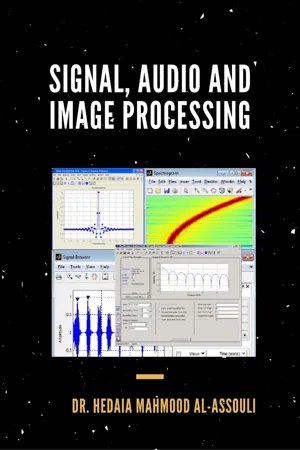
Signal, Audio and Image Processing
Dr. Hidaia Mahmood Alassouli
- 73 pages
- English
- ePUB (mobile friendly)
- Available on iOS & Android
Signal, Audio and Image Processing
Dr. Hidaia Mahmood Alassouli
About This Book
This project shows some selected signal techniques, including image and audio processing, using the Matlab digital signal processing and image processing toolboxes. The project is divided to 3 parts.Part I includes design and implementation of different types of filters for filtering signal that has different sinusoidal frequency components or noise. The comparison was made between FIR low pass flter, butterworth filter, Chebycheve Type I low pass filter and Chebycheve Type II low pass filter. Then different types of IIR Butterworth filters were designed and implemented to filter a signal that has many harmonics components, including low pass filter, high pass filter, stop band filter and band pass filter.Part II examined audio filtering in the sense of specific frequency suppression and extraction. There are many different types of filters available for the construction of filters. We will specifically use the Butterworth filter. An audio signal was read and different types of filters, including low pass filter, high pass filter, stop band filter and band pass filter, were designed and implemented in order to filter the audio signal from some frequency bands. Then the discrete cosine transform compression examined on the audio signal at different compression rates: 50%, 75%, 87.5% Part III deals with image processing; the project shows examples in smoothing, sharpening, and edge detection. Other useful operations on the image were tested, including image cropping, image resizing, image, histogram equalization and altering image brightness
Frequently asked questions
Information
1. Introduction:
2.Theory Related To Project:
- Analog and digital filter analysis
- Digital filter implementation
- FIR and IIR digital filter design
- Analog filter design Filter discretization
- Spectral Windows Transforms Cepstral analysis
- Statistical signal processing and spectral analysis
- Parametric modeling
- Linear Prediction
- Waveform generation
- Filter design and analysis Window design and analysis
- Signal plotting and analysis
- Spectral analysis Filtering signals
- Convolution and Filtering

- Filters and Transfer Functions

- Filter Coefficients and Filter Names
Table of contents
- Signal, Audio and Image Processing
- Signal, Audio and Image Processing
- Table of Contents
- 1. Introduction:
- 2.Theory Related To Project:
- 3. Descrption of Project and Results and Analysis:
- 4. Conclusion